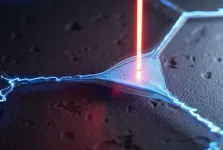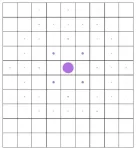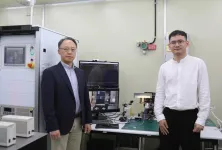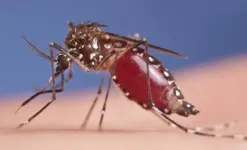(Press-News.org) Researchers at Chalmers University of Technology in Sweden and at the University of Magdeburg in Germany have developed a novel type of nanomechanical resonator that combines two important features: high mechanical quality and piezoelectricity. This development could open doors to new possibilities in quantum sensing technologies.
Mechanical resonators have been used for centuries for a multitude of applications. A key aspect of these devices is their ability to vibrate at specific frequencies. A well-known example is the tuning fork. When struck, the tuning fork oscillates at its resonance frequency, producing a sound wave within our hearing range. With advancements in microfabrication techniques, researchers have been able to shrink mechanical resonators down to the micro- and nanometer scale. At these tiny sizes, resonators oscillate at much higher frequencies and exhibit a greater sensitivity compared to their macroscopic counterparts.
“These properties make them useful in precision experiments, for example for sensing minuscule forces or mass changes. Recently, nanomechanical resonators have raised significant interest among quantum physicists due to their potential use in quantum technologies. For example, the use of quantum states of motion would improve the sensitivity of nanomechanical resonators even further,” says Witlef Wieczorek, Professor of Physics at Chalmers University of Technology and project leader of the study.
A common requirement for these applications is that nanomechanical resonators need to sustain their oscillation for long times without losing their energy. This ability is quantified by the mechanical quality factor. A large mechanical quality factor also implies that the resonator exhibits enhanced sensitivity and that quantum states of motion live longer. These properties are highly sought after in sensing and quantum technology applications.
In the quest for a material with a high-quality factor and built-in piezoelectricity
Most of the best-performing nanomechanical resonators are made from tensile-strained silicon nitride, a material known for its outstanding mechanical quality. However, silicon nitride is quite “boring” in other aspects: it doesn’t conduct electricity, nor is it magnetic or piezoelectric. This limitation has been a hurdle in applications that require in-situ control or interfacing of nanomechanical resonators to other systems. To address these needs, it is then required to add a functional material on top of silicon nitride. However, this addition tends to reduce the mechanical quality factor, which limits the resonator’s performance.
Now, researchers at Chalmers University of Technology and at the University of Magdeburg, Germany, made a big leap as they demonstrated a nanomechanical resonator made of tensile-strained aluminum nitride, a piezoelectric material that maintains a high mechanical quality factor.
“Piezoelectric materials convert mechanical motion into electrical signals and vice versa. This can be used for direct readout and control of the nanomechanical resonator in sensing applications. It can also be utilized for interfacing mechanical and electric degrees of freedom, which is relevant in the transduction of information, even down to the quantum regime,” says Anastasiia Ciers, research specialist in quantum technology at Chalmers and lead author of the study published in Advanced Materials.
The aluminum nitride resonator achieved a quality factor of more than 10 million.
“This suggests that tensile-strained aluminum nitride could be a powerful new material platform for quantum sensors or quantum transducers,” says Witlef Wieczorek.
The researchers now have two major aims: to improve the quality factor of the devices even further, and to work on realistic nanomechanical resonator designs that enable them to make use of the piezoelectricity for quantum sensing applications.
For more information:
Read the scientific article Nanomechanical Crystalline AlN Resonators with High Quality Factors for Quantum Optoelectromechanics published in Advanced Materials.
Fact box: About the aluminum nitride-based nanomechanical resonators
The researchers used a highly stressed 295 nanometer-thin film of aluminum nitride for fabricating their nanomechanical resonators. The stress was about 1GPa, the equivalent of balancing two elephants on a fingernail. The researchers used this high stress in a technique called dissipation dilution, which boosts the mechanical quality factor. The aluminum nitride film was epitaxially grown on a silicon substrate, which ensures a high crystalline quality of the film to preserve the piezoelectricity of aluminum nitride. They created a novel resonator design, called triangline, that looks like a fractal-like structure with a central triangular-shaped pad. This triangline resonator can maintain a single quantum coherent oscillation at room temperature, which is an important benchmark for its application in quantum technology.
For more information, please contact:
Anastasiia Ciers, research specialist in Quantum Technology at the Department of Microtechnology and Nanoscience at Chalmers University of Technology
anastasiia.ciers@chalmers.se
Witlef Wieczorek, Professor of Physics at the Department of Microtechnology and Nanoscience at Chalmers University of Technology.
witlef.wieczorek@chalmers.se
+46 31 772 67 72
The researchers both speak English, whilst Witlef speaks German and Swedish and Anastasiia speaks Russian. They are available for live and pre-recorded interviews. At Chalmers, we have podcast studios and broadcast filming equipment on site and would be able to assist a request for a television, radio or podcast interview.
Illustration caption: The image shows an illustration of a triangline nanomechanical resonator realized in a piezoelectric material. The central part of the resonator is shaped like a triangle that moves up and down and at the same time acts as a mirror to reflect a laser beam. The resonator is suspended by thin tethers, which are branched to minimize the loss of mechanical energy from the triangline's movement.
Illustration credit: Chalmers University of Technology | Boid
END
High-quality nanomechanical resonators with built-in piezoelectricity
2024-11-05
ELSE PRESS RELEASES FROM THIS DATE:
ERC Synergy Grants for 57 teams tackling major scientific challenges
2024-11-05
Iliana Ivanova, Commissioner for Innovation, Research, Culture, Education and Youth, said: “Innovation thrives on collaboration, especially when tackling the pressing scientific challenges of our time. The ERC Synergy Grants work with Horizon Europe funding to connect brilliant minds across borders and disciplines, enabling them to push the frontiers of knowledge together. I am particularly delighted to see researchers from countries with historically fewer ERC grants among the awardees, reflecting our mission to ...
Nordic research team receives €13 million to explore medieval book culture
2024-11-05
The CODICUM project brings together experts in history, literature, and bio-codicology from four Nordic universities to explore medieval knowledge networks. This groundbreaking study combines traditional humanities approaches with cutting-edge biomolecular analysis of fragments from medieval books, written on animal skin.
How book culture shaped medieval Europe
The project will investigate approximately 50,000 medieval Latin book fragments preserved in Nordic collections—one of Europe’s largest archives of medieval book culture.
"These fragments represent an extraordinary treasure trove that can transform our understanding ...
The origin of writing in Mesopotamia is tied to designs engraved on ancient cylinder seals
2024-11-05
The origins of writing in Mesopotamia lie in the images imprinted by ancient cylinder seals on clay tablets and other artifacts. A research group from the University of Bologna has identified a series of correlations between the designs engraved on these cylinders, dating back around six thousand years, and some of the signs in the proto-cuneiform script that emerged in the city of Uruk, located in what is now southern Iraq, around 3000 BCE.
The study—published in Antiquity—opens new perspectives on ...
Explaining science through dance
2024-11-05
Science can be difficult to explain to the public. In fact, any subfield of science can be difficult to explain to another scientist who studies in a different area. Explaining a theoretical science concept to high school students requires a new way of thinking altogether.
This is precisely what researchers at the University of California San Diego did when they orchestrated a dance with high school students at Orange Glen High School in Escondido as a way to explain topological insulators.
The experiment, led by former graduate student Matthew Du and UC San Diego Associate Professor of Chemistry and Biochemistry Joel Yuen-Zhou, was published in Science Advances.
“I ...
Pioneering neuroendocrinologist's century of discovery launches major scientific tribute series
2024-11-05
Tucson, Arizona, 5 November 2024 – Brain Medicine has launched an ambitious Festschrift series with the first of more than ten planned articles celebrating Dr. Seymour Reichlin's centennial year and his transformative impact on neuroendocrinology. The opening editorial, chronicling his revolutionary insights into brain-hormone interactions, inaugurates what promises to be one of the most comprehensive tributes in the field's history.
“One could be both a physician caring for patients and a scientific investigator,” reflects Dr. Reichlin, whose work spanning nearly 80 years has fundamentally reshaped our understanding of how ...
Gendered bilingualism in post-colonial Korea
2024-11-05
In the 1960s, Japanese books became immensely popular in South Korea. Interestingly, Korean newspapers often wrote about this trend as if mainly women were interested in learning Japanese.
Osaka Metropolitan University Associate Professor Jinsuk Yang examined South Korean newspaper articles and other historical documents from the 1960s and 1970s to understand why Japanese language learning was often described as something women did, even though men were also learning Japanese. Additionally, Professor Yang studied how women’s ability to speak Japanese affected ...
Structural safety monitoring of buildings with color variations
2024-11-05
As buildings age, the demand for effective monitoring of their structural integrity has grown significantly. A breakthrough in nano-optical sensor technology now enables precise, real-time measurement of structural deformation and stability. This innovation promises to reshape the field of structural diagnostics, offering a cost-effective, time-efficient solution that reduces the need for specialized expertise traditionally required in this area.
Led by Dr. Jae Sung Yoon, Principal Researcher at the Nano-lithography & Manufacturing Research Center within the Nano-convergence ...
Bio-based fibers could pose greater threat to the environment than conventional plastics
2024-11-05
Bio-based materials may pose a greater health risk to some of the planet’s most important species than the conventional plastics they are designed to replace, a new study has shown.
Such materials are increasingly being advocated as environmentally friendly alternatives to plastics, and used in textiles and products including clothing, wet wipes and period products.
However, microfibres of the materials are emitted into the environment through the laundry cycle, the application of sewage sludge as fertilisers, or the simple wear and tear of textile products.
Despite increasing quantities of bio-based products being produced and sold all over the world, there has been ...
Bacteria breakthrough could accelerate mosquito control schemes
2024-11-05
Mosquito larvae grow faster if they’re exposed to particular bacteria, according to a new study that could help global health programmes.
Aedes aegypti mosquitoes spread illnesses including dengue, yellow fever and Zika.
Anti-disease programmes breed and release non-biting male mosquitoes that are either sterile or prevent transmission of diseases.
These mass release programmes can be substantially more effective than the widespread spraying of insecticides, as these insects have developed resistance to many commonly employed chemicals.
The new study, by ...
Argonne to help drive AI revolution in astronomy with new institute led by Northwestern University
2024-11-04
The U.S. National Science Foundation and Simons Foundation have selected a group of institutions, including Argonne, to receive funding to establish an AI and astronomy institute called the NSF-Simons AI Institute for the Sky (SkAI).
Part of a groundbreaking effort to harness artificial intelligence (AI) to unlock the mysteries of the cosmos, the U.S. Department of Energy’s (DOE) Argonne National Laboratory is a key collaborator in the newly launched NSF-Simons AI Institute ...









